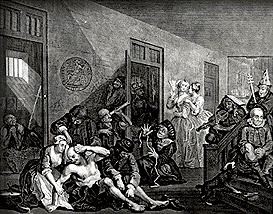Bethlem Royal Hospital
|
|
The Bethlem Royal Hospital of London, which has been variously known as Bethlem Hospital, Bethlehem Hospital and Bedlam, is the world's oldest psychiatric hospital.
| Contents |
History of Bethlem
Bethlem has been a part of London since 1247, first as a priory for the sisters and brethren of the order of the Star of Bethlehem. Its first site was in Bishopsgate Street (where Liverpool Street station now stands). In 1330 it is mentioned as a hospital, and it is documented that in 1403 some of the first lunatics were there. Colloquially known as Bedlam, it was handed over by Henry VIII with all its revenues to the city of London as a hospital for lunatics in 1547.
Bethlem Royal Hospital became famous and afterwards infamous for the brutal ill-treatment meted out to the insane. In 1675 Bedlam moved to new buildings in Moorfields, outside the City boundary. In the 18th century people used to go there to see the lunatics. For a penny one could peer into their cells, view the freaks of the "show of Bethlehem" and laugh at their antics. In 1814, there were 96,000 such visits. The lunatics were first called "patients" in 1700, and "curable" and "incurable" wards were opened in 1725-34. In 1815, Bedlam was moved to St George's Fields, Lambeth (into buildings now used to house the Imperial War Museum). Finally, in 1930, the hospital was moved to an outer suburb of London, on the site of Monks Orchard House between Eden Park, Beckenham and Shirley.
Bethlem was most notably portrayed in a scene from William Hogarth's A Rake's Progress (1735), the story of a rich merchant's son whose immoral living causes him to end up in a ward at Bethlem. This reflects the view of the time that madness was a result of moral weakness, leading to 'moral insanity' to be used as a common diagnosis.
The word "Bedlam" has long been used for lunatic asylums in general, and later for a scene of uproar and confusion.
In another old English use of the word, "a Bedlam" (or more colloquially a "Tom O' Bedlam") signified one discharged from Bethlem Hospital and licensed to beg. Such persons wore a tin plate on their arm as a badge and were known as Bedlamers, Bedlamites, or Bedlam Beggars.
Bethlem Royal today
BethlemRoyalHospital.jpeg
Bethlem Royal Hospital is now part of the South London & Maudsley NHS Trust ('SLAM'), along with the Maudsley Hospital in Camberwell. SLAM provides mental health and substance misuse services to people from Croydon, Lambeth, Southwark and Lewisham. There are a range of services at the Hospital, from substance misuse and eating disorders services to units for children and adolescents.
Until the 1990s, the hospital and its grounds were in the London Borough of Croydon, but were swapped with the London Borough of Bromley for South Norwood Country Park. This has meant that the hospital is now located in a community which it does not primarily serve. This tension caused most difficulty when SLAM sought planning permission for an expanded Medium Secure Unit in 2001 and extensive further works to improve security, much of which would be on Metropolitan Open Land. Local residents groups organised mass meetings to oppose the application, with accusations that it was unfair most patients could be from inner London areas and therefore not locals and that drug use was rife in and around the Hospital. Bromley Council eventually refused the application, with Croydon Council also objecting. However the Office of the Deputy Prime Minister overturned the decision to refuse in 2003, although no development has been yet seen on site.
Museum and Archives
Since 1970 there has been a small museum at Bethlem Royal Hospital. It is open to the public on weekdays. The museum is mainly used to display items from the museums art collection, which specialises in work by artists who have suffered from mental health problems, such as former Bethlem patients Richard Dadd and Louis Wain. Other exhibits include a pair of statues by Caius Gabriel Cibber known as Raving and Melancholy Madness, from the gates of the 17th century Bethlem Hospital, 18th and 19th century furniture, and documents from the archives. Due to the size of the museum only a small fraction of the collections can be displayed at one time, and the exhibits are rotated periodically.
Bethlem Royal Hospital possesses extensive archives from Bethlem Hospital, the Maudsley Hospital and Warlingham Park Hospital, and some of the archives of Bridewell Hospital. There are documents dating back to the 16th century, as well as full modern patient records. The archives are open for inspection by appointment, subject to the laws of confidentiality governing recent patient records.
The Bethlem Royal Hospital Archives and Museum is governed by a registered charity called the Bethlem Art and History Collections Trust.
Notable patients of Bethlem hospital
- Lemuel Francis Abbott, portrait painter
- Hannah Chaplin, mother of film actor Charlie Chaplin.
- Richard Dadd, artist.
- James Tilly Matthews, tea merchant.
- Daniel M'Naghten, catalyst for the creation of the M'Naghten Rule (criteria for the defence of insanity in the British legal system) after the attempted murder of the Prime Minister Robert Peel.
- Louis Wain, artist.
Related articles
External links
- Bethlem Royal Hospital Archives + Museum (http://www.bethlemheritage.org.uk/)
- Museum of London: Bedlam (http://www.museumoflondon.org.uk/MOLsite/exhibits/bedlam/bedlam.htm)
- Catholic Encyclopedia: Bedlam (http://www.newadvent.org/cathen/02387b.htm)
- Bedlam, London, England (http://www.ric.edu/dcousins/europsych/bedlam.html)
- Picture of Bethlem Hospital, in its St. George's Fields location (http://www.londonancestor.com/views/vb-bethlem.htm)de:Bedlam

